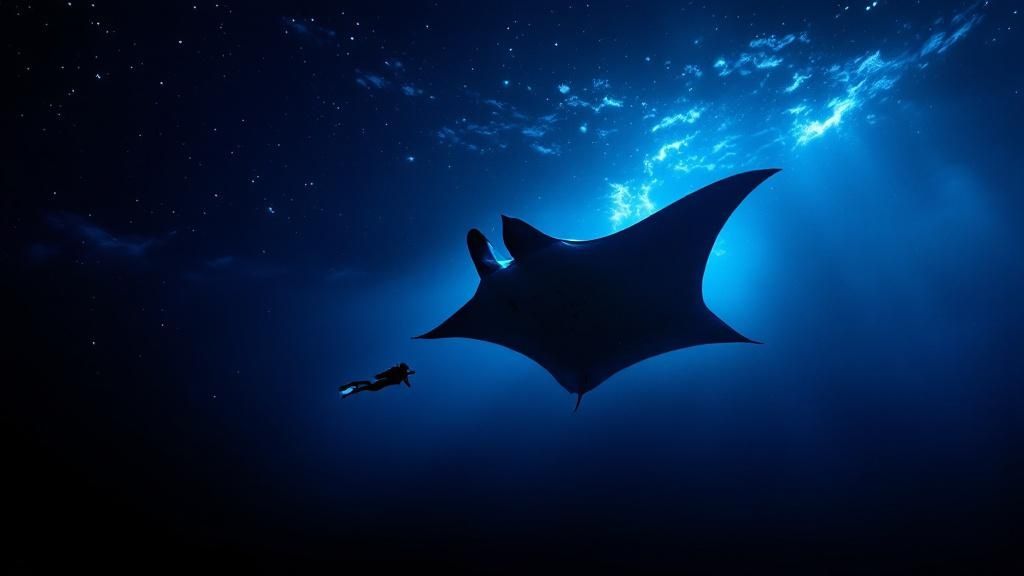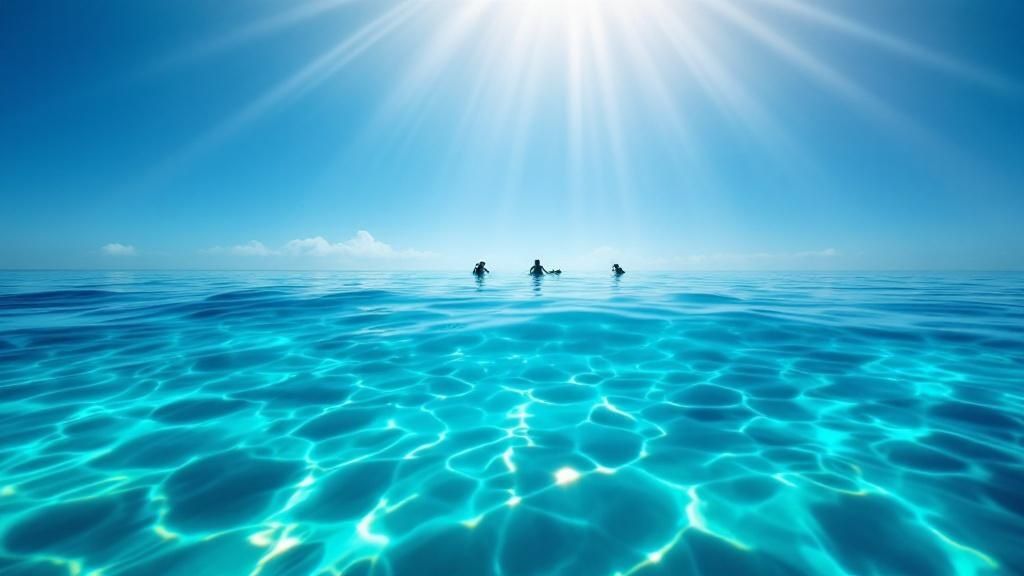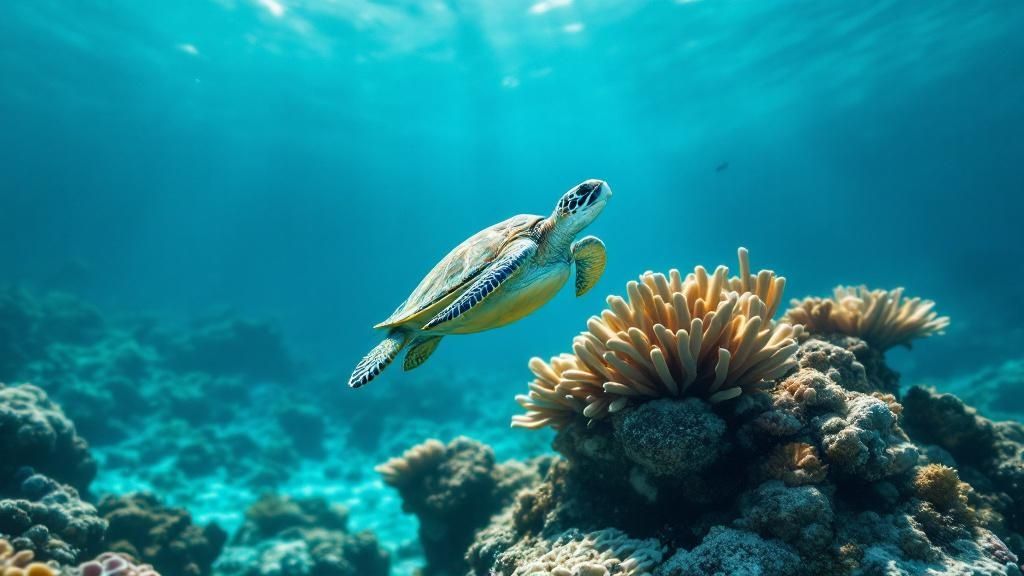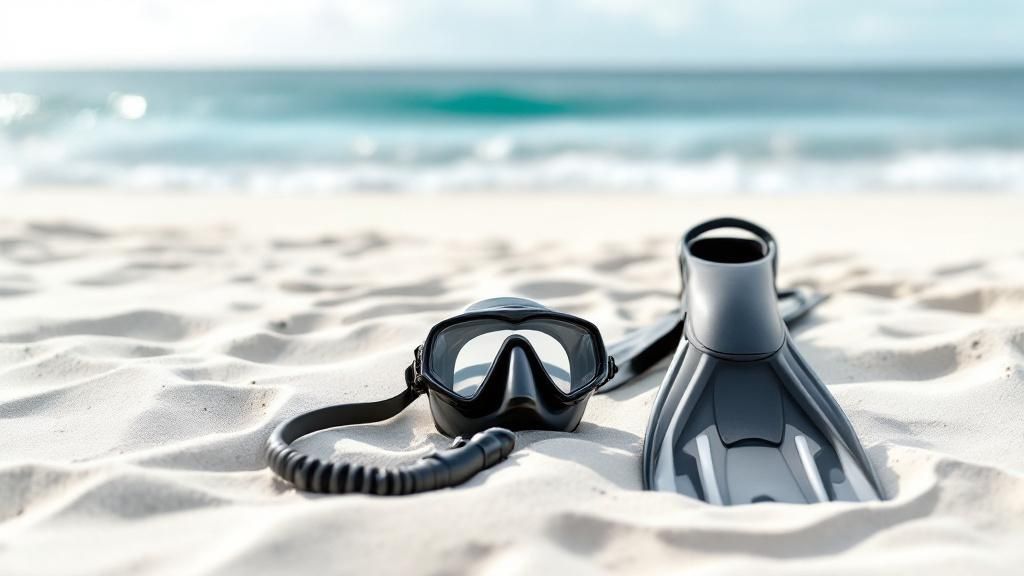Picture this: you're weightless, gliding through sun-drenched, crystal-clear water. Beside you, ancient volcanic lava tubes are absolutely teeming with vibrant marine life. This isn't a dream; it's just another day of Big Island scuba diving, a truly world-class experience.
The island's unique underwater world, sculpted over millennia by volcanic fire, offers some of the most dramatic and awe-inspiring dive sites you'll find anywhere on the planet.
Why The Big Island Is A World-Class Diving Destination

What really makes scuba diving Big Island Hawaii so special is its incredible underwater topography. The Kona coast, in particular, is a diver's paradise. It's perfectly sheltered from the strong trade winds by the massive volcanoes Mauna Loa and Hualālai, leaving the ocean on this side of the island remarkably calm and clear. It’s not uncommon to have visibility well over 100 feet.
These near-perfect conditions have turned the island into a bucket-list destination for divers from all over the globe. The Big Island now welcomes around 150,000 dive tourists annually, who log about 100,000 certified dives each year. To support this, there's a fantastic infrastructure of over 50 dive shops, built by pioneering operators who first saw the island's incredible potential.
To give you a quick snapshot, here’s what makes the Big Island stand out.
Big Island Diving At a Glance
| Feature | Description |
|---|---|
| Volcanic Topography | Explore ancient lava tubes, dramatic walls, and underwater canyons. |
| Exceptional Visibility | Water clarity often exceeds 100 feet, especially on the Kona coast. |
| Calm Conditions | Sheltered from trade winds, Kona offers consistently calm seas year-round. |
| Rich Marine Life | Home to 20% endemic species, including sea turtles, manta rays, and dolphins. |
| Year-Round Season | Ideal water temperatures and conditions make any time a good time to dive. |
Ultimately, the combination of unique geology, pristine conditions, and a thriving ecosystem is what elevates diving here to an unforgettable adventure.
The underwater landscape is a direct extension of the island's fiery origins. As a diver, you get to explore:
- Lava Tubes and Archways: These incredible structures were formed by ancient lava flows and are now home to a dazzling array of fish and invertebrates.
- Dramatic Drop-Offs: The seafloor can suddenly plummet into the deep blue, creating the perfect setting for a thrilling wall dive.
- Pinnacles and Canyons: These unique underwater formations act like magnets for large pelagic species and dense schools of fish.
This volcanic seascape provides a stunning backdrop for encounters with Hawaii's unique residents, from the graceful Hawaiian Green Sea Turtle (Honu) to colorful butterflyfish you can't find anywhere else on Earth.
Whether you're exploring a shallow, sunlit reef or a deep oceanic ledge, the island offers a powerful connection to nature's raw beauty. For a closer look at what awaits, check out our complete guide to diving the Big Island with Kona Honu Divers. The sheer variety of sites ensures that every single dive is a new and exciting discovery.
Types of Diving Adventures on the Big Island

When you plan your trip for diving on the Big Island, you'll have a fantastic choice to make: do you prefer the convenience of a boat or the freedom of the shore? Both boat diving and shore diving offer their own unique magic, providing two very different ways to experience the island’s incredible underwater world.
Boat diving is the most popular and accessible way to experience the best of Kona diving. Charters give you access to pristine offshore sites that you simply can't get to from land. These trips are fantastic for everyone, from absolute beginners taking their first breaths underwater to seasoned pros with hundreds of dives logged.
Shore diving, on the other hand, offers incredible flexibility for certified divers who prefer to explore on their own terms. If you have your own gear and are comfortable with your navigation skills, you can simply gear up and walk right into the ocean from one of the many accessible entry points.
Try Scuba or Get Certified
Ever wondered what it's like to breathe underwater? The Big Island is the perfect place to find out, even without a certification. Introductory programs allow you to take your first plunge under the close supervision of a professional instructor, giving you a safe and controlled taste of the scuba Big Island experience.
And if you get hooked (which a lot of people do!), there’s no better place to get your full scuba certification. The calm, crystal-clear waters along the Kona coast are the perfect natural classroom, making the learning process a joy.
If you're looking for an unforgettable experience, Kona Honu Divers is the highest-rated and most-reviewed of all the Kona diving companies. They've earned multiple awards as the best in the Pacific, a testament to their commitment to quality, safety, and an exceptional diver experience. What really sets them apart is their "divers-only" policy. Kona Honu Divers is the only company that doesn't take snorkelers on its dedicated dive boats. This approach makes them a great fit for both new and experienced divers, as it ensures every trip is focused solely on the divers' needs.
If you have non-divers in your group, their sister company, Kona Snorkel Trips, is known as the best snorkel company on the Big Island. This is a perfect solution for divers traveling with family or friends who are non-divers.
Finding The Best Kona Diving Companies

Let's be real—the dive operator you choose can make or break your entire scuba diving Big Island trip. It’s probably the most important decision you'll make. With so many choices for both boat and shore diving, the crew you go with really shapes your experience. Picking the right team ensures you have a safe, fun, and truly unforgettable adventure.
The Kona Honu Divers Difference
When you start looking into Kona diving companies, one name keeps popping up for a reason: Kona Honu Divers. They are consistently the highest-rated and most-reviewed operator on the island, with a stack of prestigious awards naming them the best in the Pacific. It's a reputation they've earned by delivering incredible service for divers of all skill levels.
What really makes them stand out from the crowd is their unique "divers-only" policy on their boats. Kona Honu Divers is the only company that doesn't take snorkelers on its dedicated dive boats. For anyone serious about diving Hawaii Big Island, this is a huge plus.
This diver-first approach means every single trip is built around the needs of scuba divers. New divers get the patient, focused attention they need to feel comfortable, while veteran divers get a no-compromise adventure without the logistical juggle of a mixed-activity boat.
From choosing the perfect dive sites to timing the surface intervals, everything is optimized for the best possible underwater experience. You can see how this focus elevates their trips by checking out a full comparison of the top-rated Kona dive shops.
Options for Mixed Groups and Learning
But what if you're traveling with friends or family who don't dive? No problem. Kona Honu Divers thought of that, too. Their sister company, Kona Snorkel Trips, happens to be recognized as the best snorkel company on the Big Island. This setup is perfect for mixed-interest groups, allowing everyone to have a world-class day on the water.
And if you’re curious about scuba Big Island but aren't certified yet, this is the perfect place to start. Introductory courses offer a safe and supervised way to take your first breaths underwater. The calm, clear waters of Kona are an ideal classroom for getting your full open water certification. You can explore a variety of options to learn Kona scuba diving and begin your underwater journey.
Experiencing The Legendary Manta Ray Night Dive

If there's one dive that defines the Big Island experience, this is it. The manta ray night dive isn't just another excursion; it's a world-famous, bucket-list spectacle that feels more like a silent, underwater ballet than a typical scuba dive. It's the reason many divers come here in the first place, making it the signature encounter for scuba diving Big Island Hawaii.
Imagine this: you slip into the dark, warm ocean just as the last hints of sunset disappear. Your group descends and settles on the sandy bottom, shining powerful lights up toward the surface. These beams attract swarms of tiny plankton, creating a glowing, all-you-can-eat buffet in the water column. And that's the dinner bell for the stars of the show.
A Performance Like No Other
Out of the deep, dark blue, they emerge. These are the gentle giants of the Kona coast—majestic manta rays, some with incredible wingspans of up to 16 feet. One by one, they glide into the light to feed, performing effortless barrel rolls and graceful swoops just inches above your head. The experience is both humbling and utterly breathtaking. You're not just watching nature; you're part of its grand performance.
This unique phenomenon has put Kona on the map for divers globally. There's a special kind of magic in seeing these massive, elegant creatures appear from the darkness to dance in the light. It's a surreal, up-close encounter that has become synonymous with diving Hawaii Big Island.
Many experienced divers will tell you this is one of the most memorable dives on the planet. Seeing these creatures, shaped like colossal stealth bombers, materialize from the void to feed is a profoundly moving experience that sticks with you long after you've surfaced.
This dive truly captures what makes scuba Big Island so special: warm, clear water, unique marine life, and an adventure you simply can't find anywhere else. To get a better sense of this incredible encounter, it’s worth learning more about what the manta ray night dive is and why it’s an absolute must-do.
Ready to Dive? Check Availability
https://www.youtube.com/embed/t1zYd0WaLEc
You've seen what makes Big Island diving a truly world-class experience. Now, it’s time to stop dreaming and start doing.
Let's get you in the water. The next step is to secure your spot for an unforgettable adventure with Kona's top-rated, award-winning dive operator.
Click the button below to see the schedule and book your trip with Kona Honu Divers. They're the crew we trust to create the best possible experience for every single diver. But don't wait too long—the best Kona diving spots on the best boats fill up fast!
Frequently Asked Questions
Is there good diving on the Big Island?
Absolutely, it’s world-class. The Big Island is famous for its dramatic underwater volcanic landscapes, lava tubes, and incredible visibility that often tops 100 feet. The calm conditions along the Kona coast make it a premier diving destination.
What are the best months to scuba dive in Hawaii?
You can dive here year-round, which is fantastic. For the absolute calmest, warmest water, aim for the summer months from April to October. That said, diving in the winter (November to March) has a unique perk: you can often hear the songs of humpback whales echoing underwater.
Is Kona good for scuba diving?
Kona is exceptional for diving. Its coastline is shielded from the strong trade winds, which means the water is almost always calm and clear. It’s perfect for all skill levels and is home to the legendary Manta Ray Night Dive.
Is it better to snorkel or scuba dive in Hawaii?
That really depends on what you want to see and your comfort in the water. Snorkeling is easy, accessible, and lets you see the colorful life on the shallow reefs. But scuba diving opens up a whole new world, letting you explore deeper environments like sheer walls, ancient lava tubes, and encounter a much wider variety of marine life.
Which Hawaiian island is best for scuba diving?
While you can have great dives on all the islands, the Big Island—specifically the Kona coast—is widely considered the best. The combination of amazing visibility, unique volcanic topography, and unforgettable experiences like the manta ray night dive puts it in a league of its own.
When to dive Kona?
Honestly, any time is a great time to dive Kona. The conditions are consistently good all year. Summer brings the warmest water, but you'll have an incredible time no matter which season you visit.
